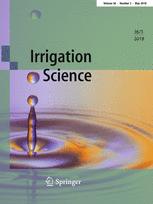Ver ítem
- xmlui.general.dspace_homeCentros Regionales y EEAsCentro Regional Mendoza - San JuanEEA JunínArtículos científicosxmlui.ArtifactBrowser.ItemViewer.trail
- Inicio
- Centros Regionales y EEAs
- Centro Regional Mendoza - San Juan
- EEA Junín
- Artículos científicos
- Ver ítem
Effect of regulated deficit irrigation during the vegetative growth period on shoot elongation and oil yield components in olive hedgerows (cv. Arbosana) pruned annually on alternate sides in San Juan, Argentina
Resumen
In super-intensive hedgerows, vegetative vigor must be controlled to allow access to harvesting machinery, particularly under Argentina conditions in which olive trees display excessive vigor. During shoot growth (spring–early summer), flowering and fruit set also take place and the potential yield (bud number) for the following season is defined. The effect of spring–early summer deficit irrigation was studied as a tool to reduce vegetative growth and
[ver mas...]
In super-intensive hedgerows, vegetative vigor must be controlled to allow access to harvesting machinery, particularly under Argentina conditions in which olive trees display excessive vigor. During shoot growth (spring–early summer), flowering and fruit set also take place and the potential yield (bud number) for the following season is defined. The effect of spring–early summer deficit irrigation was studied as a tool to reduce vegetative growth and its influence on inflorescence development, oil yield, and its components. During three seasons in an olive hedgerow (cv. Arbosana), we evaluated a control irrigated at 70% ETc over the season and two regulated deficit treatments irrigated at 50% (RDI-1) and 30% (RDI-2) ETc during the shoot growth period (from August to January) and then 70% ETc until harvest (May). Hedgerows were mechanically topped and pruned annually on alternate sides. We observed that RDI-1 and RDI-2 reduced hedgerow height and width increment after hedging by 15% and 20%, respectively, compared to control. Inflorescence structures were not affected by water deficit, but the control treatment showed on average 5.8 fruits per fruiting inflorescence, significantly higher than 2.4 fruits per fruiting inflorescence observed in RDI-2. After the third season, RDI-1 and RDI-2 were 174% and 146% more productive than control hedgerows, where the pruned sides showed excessive vigor with lower floral bud induction in the following seasons. Fruit size and oil accumulation were also higher in both RDI-1 and RDI-2 than in control, due to greater fruit exposure to irradiance in most deficit treatments. Compared with control, RDI-1 and RDI-2 allowed water savings of 17% and 35%, respectively, but RDI-1 was more productive and had lower alternate bearing than RDI-2.
[Cerrar]

Fuente
Irrigation Science : 1–14 (First Online: 19 April 2019)
Fecha
2019-04
Editorial
Springer
ISSN
0342-7188
1432-1319
1432-1319
Formato
pdf
Tipo de documento
artículo
Palabras Claves
Derechos de acceso
Restringido
 Excepto donde se diga explicitamente, este item se publica bajo la siguiente descripción: Creative Commons Attribution-NonCommercial-ShareAlike 2.5 Unported (CC BY-NC-SA 2.5)
Excepto donde se diga explicitamente, este item se publica bajo la siguiente descripción: Creative Commons Attribution-NonCommercial-ShareAlike 2.5 Unported (CC BY-NC-SA 2.5)

